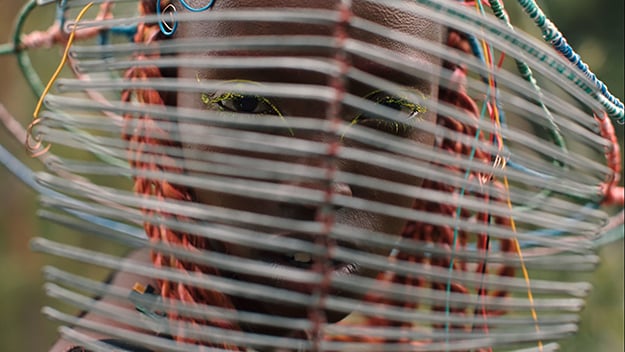Art and Craft: Neptune Frost
This article appeared in the June 23, 2022 edition of The Film Comment Letter, our free weekly newsletter featuring original film criticism and writing. Sign up for the Letter here.

Neptune Frost (Saul Williams and Anisia Uzeyman, 2021)
Saul Williams and Anisia Uzeyman’s sci-fi musical, Neptune Frost, opens with a striking instance of an oppositional gaze: Neptune—played here by Cheryl Isheja, one of two actors embodying the character in the film—spins around to face the camera in close-up. Isheja’s appearance is arresting: her eyelids and lashes are tinged with gold, and her face is partly concealed by a mesh headpiece that looks like the skeleton of a strange fish. It’s a fitting opening for a film that is concerned with the aesthetics of revolution—whether in the realm of the body, the geopolitical order, or the politics of the image.
Neptune Frost tracks the activities of a gender-fluid, multi-lingual collective of African hackers, dissidents, and miners who take on the global economy that runs on coltan—an ore crucial to the production of many electronic devices and primarily found in the Democratic Republic of Congo. Focusing on those who bear the material brunt—the labor, the waste—of our increasingly dematerialized technological reality, the film explores its ideas less through narrative than through a painstakingly conceived diegetic world, where each object, whether a prop or a costume, draws on and reinvents African, decolonial, and queer traditions.
Majestic headdresses like the one worn by Neptune in the film’s opening shot are a feature of the work of Cedric Mizero, the film’s costume and set designer. In an interview, Mizero said, “I wanted to exaggerate the idea of the mask: you see her face but you also don’t see her face … It’s still all recycled materials but with a regal vibe to it.” His creations draw on the protective headdresses worn by ancestral warriors and Rwandan traditional hairstyles such as Amasunzu, an exuberant sculptural coiffure in which some sections are shaved to the scalp while others are grown out and trimmed into elaborate parabolic shapes. Mizero’s emphasis on the head is in keeping with its importance in African arts and traditions, as reflected in the Yoruba concept of ori, which means head, but also fate and destiny.
The film’s look has been described widely as Afrofuturist, a term for an aesthetic movement that imagines speculative or alternate realities through an African and Afro-diasporic lens. For Mizero, Uzeyman, and Williams, this is an ill-fitting label that nonetheless functions as an entry point into their work. “I didn’t have a line that required it to look Afrofuturistic or even sci-fi,” said Mizero, who grew up in Gishoma, a small village in Rwanda. “I was doing something that was happening in the present, drawing from a creative expressiveness that you can notice if you come to Rwanda.”
Dedicated to taking fashion out of urban runways and into the village, the designer’s approach is radical in its insistence that we pay attention to the inherent innovation and surrealism of people and places most often represented in the media in an ethnographic light. Neptune Frost, for instance, makes inspired use of objects that were once negatively coded—like the large, sturdy, and colorful “Ghana Must Go” bags, referred as such due to their use by Ghanaians who were expelled from Nigeria in 1983—that have been reclaimed as fashion emblems by contemporary African artists.
One of Mizero’s favorite designs was for the character “Potolo the Avatar,” a being from an alternate reality who appears to Neptune and fellow rebel Matalusa in a dreamscape, narrating an origin story inspired by both computer programming and Dogon mythology. The idea of the binary, central to both, is visualized in Potolo’s various hairstyles: platinum blond braids wound up like bicycle wheels on each side of his head; Fulani-style puff ponytails, realized by hair and makeup designer Tanya Melendez. As Potolo hovers in the air, the multi-colored wheels attached to his back spin above him like a constellation, bringing to mind the Sirius binary star system that, according to Dogon folklore, is the home of an alien race that imparted its ancient knowledge to the human tribe. (The character’s name also comes from the Dogon for Sirius B, Po Tolo.)
Mizero explained the process behind this technically complex and allegorically layered costume: “I created this in collaboration with someone on my team who works with scraps and creates ‘scraptures.’ This was all manual, there wasn’t a remote control. We made it out of bike [wheels]. We really wanted something that felt like a dream, that moved like he was landing from space.”
The inventiveness and resourcefulness of the film draws on Mizero’s everyday experiences of life in Rwanda: “We don’t throw things away,” he said of the Rwandan mindset. “We know that things have second, third, multiple lives, from outdated technology to the barrels we use for water. It’s part of our culture.”
This approach permeates every aspect of the film: the hypnotic score by Williams and the Burundian ensemble Club Himbaza uses the digging tools of coltan miners as musical instruments; the hackers’ translucent, octogonal phones and wooden guns, created by prop designer Yves Minani, gesture toward traditional woodcraft; and the vest and sandals worn by Matalusa are made of discarded computer keyboards and circuit boards. In conversation with a larger, continental artistic movement, these salvage aesthetics highlight the mundane beauty of repurposed objects in a world defined by the unbridled production of waste at the expense of human and other forms of life.
Chrystel Oloukoï is a researcher, freelance film critic, and curator broadly interested in Black diasporic and continental experimental cinema.







